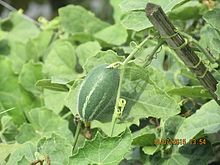Trichosanthes dioica
| Trichosanthes dioica | |
|---|---|
 |
|
| Scientific classification | |
| Kingdom: | Plantae |
| (unranked): | Angiosperms |
| (unranked): | Eudicots |
| (unranked): | Rosids |
| Order: | Cucurbitales |
| Family: | Cucurbitaceae |
| Genus: | Trichosanthes |
| Species: | T. dioica |
| Binomial name | |
|
Trichosanthes dioica Roxb. |
|
Trichosanthes dioica is also known as the pointed gourd, is a vine plant in the Cucurbitaceae family, similar to cucumber and squash, though unlike those it is perennial. It is a dioecious (male and female plants) vine (creeper) plant with heart-shaped leaves (cordate) and is grown on a trellis. The fruits are green with white or no stripes. Size can vary from small and round to thick and long — 2 to 6 inches (5 to 15 cm). It thrives well under a hot to moderately warm and humid climate. The plant remains dormant during the winter season and prefers a fertile, well-drained sandy loam soil due to its susceptibility to water-logging.
Trichosanthes dioica is known as:
Colloquially, in India, it is often called green potato. It is widely cultivated in the eastern and some northern parts of India, particularly in North eastern Andhra, Odisha, Bengal, Assam, Bihar, and Uttar Pradesh. It is used as an ingredient for soup, stew, curry, sweet, or eaten fried and as potoler dorma or dolma (dolma) with fish, roe or meat stuffing.
Pointed gourd is provincially known as potol. It is a vital summer vegetable in Bangladesh. It is cultivated and consumed in every part of Bangladesh. It is a perennial crop and sold at the end of October when there is a shortage of other alternative vegetables.
Pointed gourd is a good source of vitamin and minerals. It is a good source of carbohydrates, vitamin A, and vitamin C. It also contains major nutrients and trace elements (magnesium, potassium, copper, sulfur, and chlorine) which are needed in small quantities, for playing essential roles in human physiology. 9.0 mg Mg, 2.6 mg Na, 83.0 mg K, 1.1 mg Cu and 17 mg S per 100 g edible part.
...
Wikipedia
